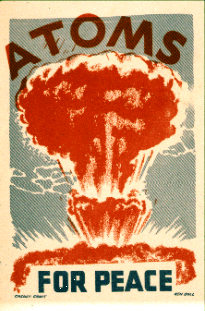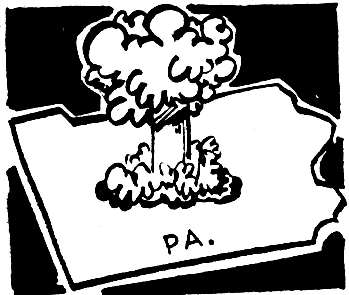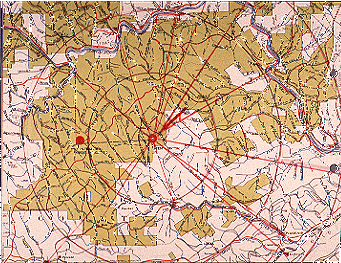


Spectacular Ideas in Marginal Landscapes:
Project Plowshare in
Pennsylvania
 ABSTRACT:Project Ketch, part of the the Atomic Energy Commission's
(AEC) Plowshare initiative, proposed the detonation of a 24 kiloton atomic bomb
3300 feet underground in a State Forest in north-central Pennsylvania. The
resulting sub-surface cavity was to be used to store natural gas for distribution
in Pennsylvania and other north-eastern states. Proponents of Project Ketch, the
AEC and Columbia Gas Corporation, engaged the discourses of geographic
engineering (planetary-scale landscape modification with atomic explosives),
economic development, and marginality to justify the project, to enable the blast
to take place. Public debate disputed and resisted these discourses, recasting
the selected ground zero in different and sometimes contradictory ways, leading
to the cancellation of Project Ketch. This paper examines how a particular
"marginal" landscape was contentiously made and remade to suit different
intentions and motivations, focusing on the relations between the spectacular and
the marginal as they played out in a quiet woods in Pennsylvania.
ABSTRACT:Project Ketch, part of the the Atomic Energy Commission's
(AEC) Plowshare initiative, proposed the detonation of a 24 kiloton atomic bomb
3300 feet underground in a State Forest in north-central Pennsylvania. The
resulting sub-surface cavity was to be used to store natural gas for distribution
in Pennsylvania and other north-eastern states. Proponents of Project Ketch, the
AEC and Columbia Gas Corporation, engaged the discourses of geographic
engineering (planetary-scale landscape modification with atomic explosives),
economic development, and marginality to justify the project, to enable the blast
to take place. Public debate disputed and resisted these discourses, recasting
the selected ground zero in different and sometimes contradictory ways, leading
to the cancellation of Project Ketch. This paper examines how a particular
"marginal" landscape was contentiously made and remade to suit different
intentions and motivations, focusing on the relations between the spectacular and
the marginal as they played out in a quiet woods in Pennsylvania.
KEYWORDS: atomic explosions, geographic engineering, marginal landscapes,
economic development
A longer version of this paper, published as Project Ketch: Project Plowshare in Pennsylvania, is available.
"The possibilities are truly fantastic.... It is the big sizes that excite the
imagination. They might literally reshape the earth." (Mann 1975, p. 77)
A shrill headline in the Pittsburgh Press on Valentines day 1967 announced an underground atomic blast being studied for a location in central Pennsylvania. The article, based on secret information uncovered by a Pittsburgh Press reporter, initiated a direct relation between the spectacular and the marginal. Penn State Nuclear Engineer Nunzio Palladino recalls his initial reaction to the announcement: "My God, right here in Pennsylvania" (Washington Post). Simultaneously, the newspaper article pithily noted that "the site...must be rather remote" (Pittsburgh Press). The spectacular: the Atomic Energy Commission s Project Plowshare, an applied exercise in "geographic engineering," planetary-scale landscape manipulation with nuclear explosives, part of the Atoms for Peace program s search for peaceful uses of atomic energy. The marginal: a hole in the map in north-central Pennsylvania where the blast was to take place.

Drawing from Pittsburg Press letters to the editor column.
In the abstract neither Project Plowshare nor the marginal seemed contentious. The geographic engineering ideas behind Project Plowshare were science fiction - "engineers dreams" as Willy Ley (1954) has called them; a discourse of speculations about grandiose modifications of the physical environment at a geographic and planetary scale, drawing upon a long cultural history of such dreams. The discourse of the marginal - both landscape and humans - also not very contentious: empty landscapes with few people engaged in minimal economic activity, a negative space, wild, remote, a forgotten periphery to some disinterested core; a common way to frame such human landscapes, if we think of them at all. In the case of Project Plowshare and its application in Project Ketch, as the planned explosion in central Pennsylvania was dubbed, the spectacular and the marginal came together. In the process, a third, and also seldom problemetized discourse was engaged, that of economic development. Together the discourses of geographic engineering, economic development, and marginality were used as a means of realizing Project Ketch and the peaceful use of atomic explosives. Yet in the process of converging on a real geography, enabling Plowshare to take place, the three discourses became bitterly contentious.

Planning map (manuscript) for Project Ketch 'ground zero.'
This paper articulates the process by which the discourse of the spectacular - Project Plowshare and geographic engineering - was historically, culturally, and politically constructed. It articulates the historical and cultural background of the idea of geographical and planetary engineering and the troubled history of atomic energy technology, while placing Project Plowshare within the Cold War context which transformed this "engineer s dream" into reality, a shill in the psychological warfare of the Cold War. The strategy behind Project Ketch was hatched by the Atomic Energy Commission (AEC) and the Columbia Gas Corporation, the latter interested in storing natural gas in chambers created by thousands of underground atomic blasts. I argue that in order to realize the spectacular - Project Plowshare - a marginal landscape with marginal people was necessary. But marginality must be produced and constructed before it can be utilized: marginality needs to be engineered before the geographic engineering can take place. The story of Project Ketch in Pennsylvania provides a means of examining the discourse of the marginal as developed and applied to a particular landscape and people. I also argue that a discourse of economic development was stealthily wielded as a means of justifying the application of atomic explosions for geographic engineering while simultaneously framing the selected ground zero and its people as needy, lacking, and underdeveloped; casting a human and physical landscape so as to be worthy of an atomic blast.
The AEC and Columbia Gas planned and developed Project Ketch within the overlapping and unproblemitized discourses of geographical engineering, economic development, and marginality, shaping and crafting their particular ground zero of choice for more than a year and a half before contacting Pennsylvania officials. Once suitably prepared and with a well-crafted ground zero in place, the AEC and Columbia Gas contacted Pennsylvania officials, demanding secrecy, strictly framing conversations within the three discourses, and further shaping ground zero. After another year of planning, the AEC, Columbia Gas, and Pennsylvania officials prepared to publicly announce Project Ketch and the ground zero. The leak in the Pittsburgh newspaper upset this careful process, but after initial confusion momentum was regained. The AEC, Columbia Gas, and Pennsylvania officials focused on publicly justifying the project and ground zero in terms of the discourses of geographic engineering, economic development, and marginality. Yet once in the public sphere the discourses were not so uncritically accepted. The converging discourses, focused on particular landscape in north central Pennsylvania, raised contentious debates which questioned and resisted the discourses of geographic engineering, economic development, and the marginal.
Project Ketch in Pennsylvania illustrates the complex and contentious process by which a marginal landscape and people were produced in the process of applying the idea of geographical engineering to a real geography. The demise of Project Ketch and eventually Project Plowshare, their demotion back to engineers dreams, traces its origins to public disputes focused on particular landscapes, landscapes cast in a certain manner because they had to be that way if Project Plowshare was to be successful - was to take place. Resistance to geographic engineering, economic development, and marginality disputed these discourses, offering alternative discourses and different, sometimes contradictory visions of the ground zero landscape. Regardless of the fact that Project Ketch never took place in the tangible sense of an actual explosion, the Project did make place - it resulted in disputed constructions of a marginal landscape and people, revealing the contentious and complex character of such landscapes and people.
E-mail: jbkrygie@cc.owu.edu